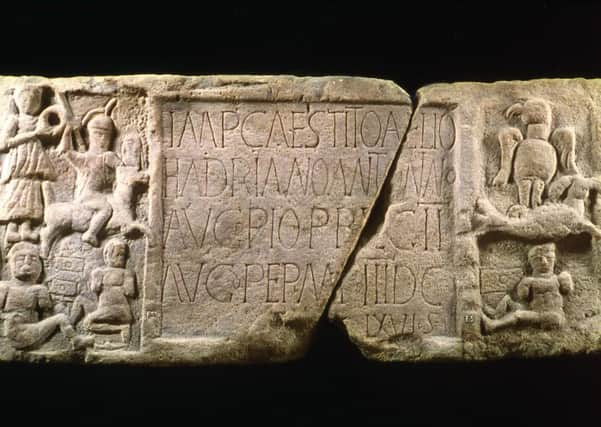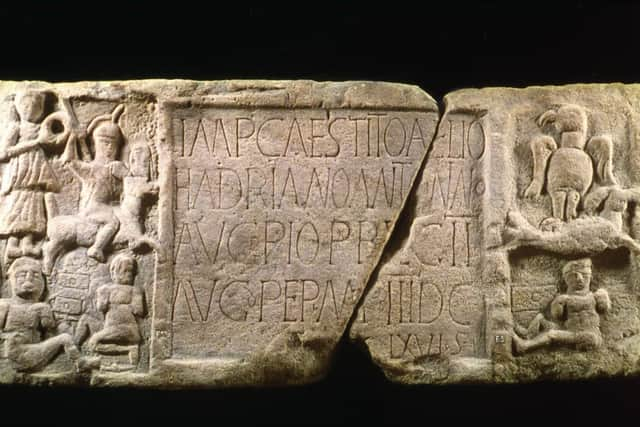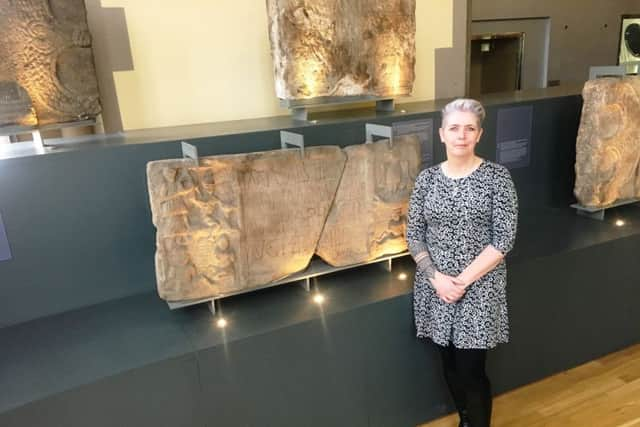Original colour scheme of Antonine Wall revealed


Dr Louisa Campbell, of Glasgow University’s archaeology department, has traced miniscule pigments on the wall’s distance stones, which were created by the Roman Legions to chart construction progress, using X-ray and laser technology.
It is the first time the kit has been successfully used for this type of archaeological investigation with Dr Campbell able to build up an accurate picture of the colour scheme deployed by the Romans 2,000 years ago.
Advertisement
Hide AdThe results “cast new light” on how the wall appeared to both the Roman soldiers and local population at the time with the colours used to enhance the impact of the “propaganda” of the occupying forces.


The research has shown that red was used to paint both the cloaks of Roman officers and drops of blood of their captives with shades of ochre used to build up skin tones.
Dr Campbell, Historic Environment Scotland’s postdoctoral fellow in archaeology at the University of Glasgow, said: “The public are accustomed to seeing these sculptures in bland greys and creams and do not get the full impact that they would have had on the Roman and indigenous audiences 2000 years ago.
“The work has really been able to cast new light on these stones. It allows you to reimagine these stones and how they would have looked at the time.
“The iconography of the stones is very powerful and it really tells us a story in its own right. From the Roman perspective, they are really establishing the control. The stones are a form of propaganda used to subjugate the local population.”


The Antonine Wall, made from turf and timber, spanned around 37 miles between the Firth of Forth and the Firth of Clyde.
Advertisement
Hide AdAt one point, up to 7,000 men were stationed along the wall in seventeen forts and several smaller enclosures.
The frontier was abandoned around 162AD, roughly 20 years after it was first ordered by Roman Emperor Antoninus Pius, with the forces withdrawing to Hadrian’s Wall.
Advertisement
Hide AdDr Campbell’s research, which was funded by Historic Environment Scotland, focused on distance stones which were ornately engraved made by the Roman Legions to record their building achievements.


One, the Summerston, was found on a farm near Bearsden at what was probably a base for the construction crew of the Second Legion.
The slab reads: “For the emperor Caesar Titus Aelius Hadrianus Antoninus Augustus Pius, Father of his Country, the Second Augustan Legion (built this) over a distance of 3666 ½ paces.”
The panel on the left of the stone depicts a winged Victory - wearing a dress painted with orpiment, a lustrous golden yellow - holding a laurel wreath preparing to crown a cavalryman who rides down two bearded and bound captives.
On the right panel an eagle appears to perch on the back of a Capricorn, the emblem of the Second Legion, above another captive.


Dr Campbell added: “The local population might not have been able to read the Latin inscriptions on the stone but they would certainly have been able to understand the sculptures and the context behind them.
Advertisement
Hide Ad“It is demonstrating very clearly the power that Rome is asserting on the indigenous population.”
Dr Campbell deployed two different types of portable scanner to measure the elemental and mineral composition of the stones using X-Ray fluorescence and Raman spectroscopy.
Advertisement
Hide AdThe archaeologist was then able to extrapolate the findings to pinpoint the colours used on the carvings.
While the equipment has been used to analyse visible traces of pigments on ‘clean’ heritage objects, it has been previously been difficult to gain readings from artefacts which have been battered by environmental conditions, such as the distance stones.
Following Dr Campbell’s breakthrough, it is now hoped to create new physical replicas of the distance stones complete with original colourings, as well as digital versions.
Her techniques are also due to be applied to other archaeological gems from various periods in Scottish history.
Dr Campbell added: “With his portable technology we can go into museums and really recalibrate our thinking on how we understand this type of material culture and really bring these items back to life.
“We have been talking about going into Pictish, Viking and early Christian periods. There are so many different avenues in which you can take this research.”